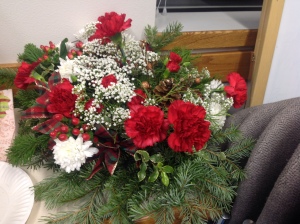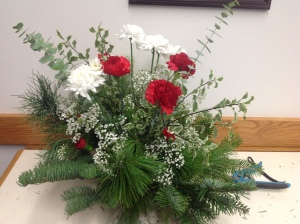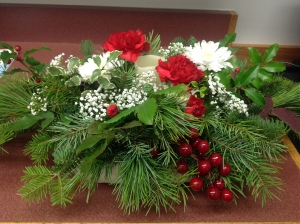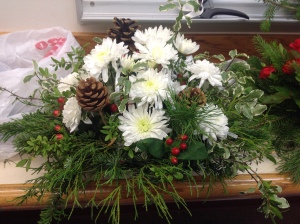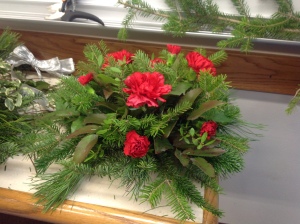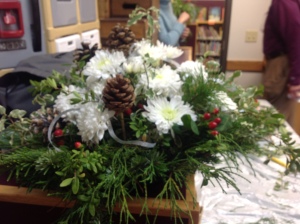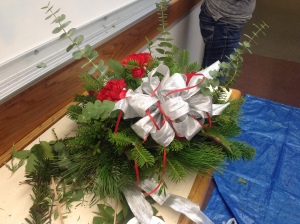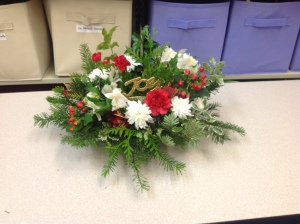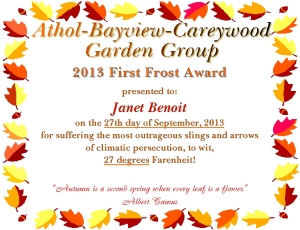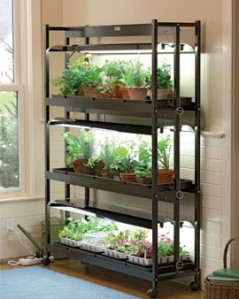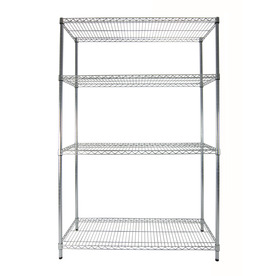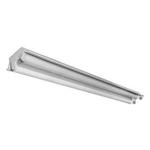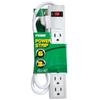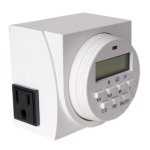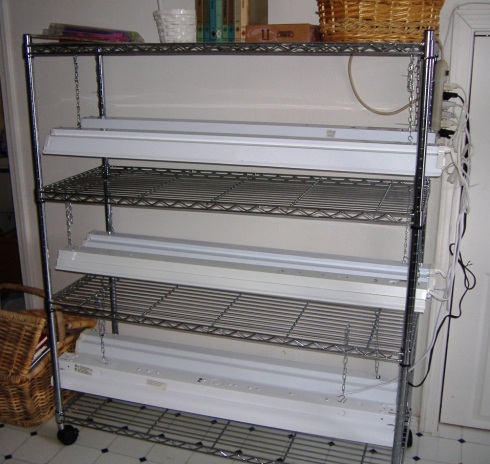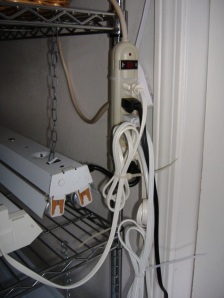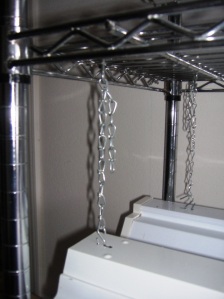I love where we live. The panhandle of Idaho is situated between two mountain ranges -– the Selkirks to the west and the Cabinets — the northern extension of the Bitteroots — to the east. The region is heavily forested and has a wealth of water resources in the form of lakes — Lake Pend Oreille, Priest Lake, Lake Coeur d’Alene — and rivers – the Kootenai, the Clark Fork, the St. Joe, and the Coeur d’Alene rivers. I guess it’s not surprising that boating, skiing, snowmobiling, hiking and other outdoor activities are pursued with passion here.
While natural beauty abounds on all sides, the region is generally also hospitable to those who want to create a little “unnatural” beauty in the form of gardens. According to one of the USDA zone hardiness finder websites, our region ranges from zone 5a to zone 6a depending on location which is a heck of lot warmer than where I grew up in central South Dakota (zone 4 – if you were lucky!). Keep in mind, though, the USDA hardiness zones are only intended to give you a sense of your average minimum low temperature (-10 for zone 6a and -30 for zone 4a) so that you can tell whether or not a plant will “over winter” in your area. Knowing your hardiness zone is a good thing, but it isn’t going to tell you whether or not a plant will flourish during your summer growing season.
There’s one area in which South Dakota, despite harsh winters, is way ahead of the Idaho Panhandle and that’s summer night-time temperatures. Summers are hot in the central northern plains — 90-100+ degrees during the day with night-time temperatures “cooling” to 70-80 degrees. While this sounds fairly ghastly as far as human comfort goes (Believe me, ghastly just doesn’t cover it!), heat-loving plants like tomatoes, peppers, melons, eggplant, etc. just lo-o-o-ve it! In fact, some plants (like the aforementioned tomatoes) won’t even ripen fruit if the night-time temperatures fall below 60 degrees.
So, what’s a tomato loving gardener to do in the Panhandle? Why, build a greenhouse of course! It is my considered opinion that, where we live, every gardener should have a greenhouse. Now, don’t start hyper-ventilating! I’m not talking about a Victorian conservatory that costs more than your house and requires a staff to maintain and operate. My Cattle Panel Greenhouse cost me about $250 to build and has grown everything from tomatoes to sweet potatoes successfully with minimal daily effort. Basically, I open the greenhouse doors in the morning, close them at night and water/fertilize as needed. Word to the Wise: It doesn’t rain in the greenhouse! Plants do die if you don’t water them so make sure you give your greenhouse plants at least the equivalent of an inch of rain a week. I water my entire garden including the greenhouses (Yes, I have more than one. Aren’t you just eaten up with envy?!) on a regular schedule that prevents greenhouse plant desiccation.
A couple of notes before we start. My cattle panel greenhouse is designed to be a permanent structure. Some cattle panel greenhouse plans are for structures that can be towed from place to place, but this isn’t one of them.
One of my biggest problems with most cattle panel greenhouse designs is the tendency of the greenhouse to collapse under the weight of winter snow. I solved that problem with a sturdy doorway at both ends that supports a king rafter to hold the cattle panels up. As a result, I can leave the plastic on my greenhouse all year round and start cool season crops in February when the ground is still covered in snow.
Another note on greenhouse plastic – buy greenhouse plastic! Don’t go to local big box store and buy the 6 mil clear construction grade plastic. It won’t last even a single season, and you’ll spend the rest of your life picking up little bits of sun-degraded plastic all over your garden. Spend the extra bucks and get heavy duty UV resistant greenhouse plastic; you’ll save money and aggravation in the long run.
I’m a little claustrophobic so some of the cattle panel greenhouse designs out there created an interior space that was just too confined for my taste. So, using a hint I picked up on another “cattle panel” website, I added an additional 6-8 inches to the height of the roof of my greenhouse (you’ll see how below) which makes both me and my plants a lot happier.
Finally, I should point out that, to a greenhouse purist, my little structure is technically just a big cold frame. It doesn’t have supplemental heating or ventilation so it’s not a “real” greenhouse. I’m happy to report that my tomatoes don’t know the difference!
Enough preamble! Let’s take a look at how you can get a greenhouse of your very own!
Cattle Panel Greenhouse Plans
Materials List:
3 (4’4” x 16’) cattle panels
5 12’ treated 2×10 boards
5 12’ treated 2×4 boards
4 8’ treated 4×4 posts
4 2’ x 8’ sheets of clear, corrugated PVC roofing
2½” deck screws
1½” deck screws
¾” deck screws
large fencing staples
greenhouse plastic – 20’ long x 20’ wide (or thereabouts)
worn out soaker hose
duct tape
36+ feet of 1×2 boards to act as slats to fasten the greenhouse plastic to the bottom support boards and door frames
hinges for doors
rope or baling twine for pulling the cattle panels together into a hoop
Tools:
cordless drill driver with both drill bits and Phillips head screwdriver bits
hammer
level
50’ tape measure
post hole digger
circular saw
sledge hammer
scissors
(1) Carry your materials and tools to the permanent location of your greenhouse. This location should be relatively level. You can adjust for some slight sloping by banking soil around the bottom of your greenhouse walls, but too much slope means the soil will just run out of your greenhouse and down the hill. Also, make sure your location isn’t shaded significantly by trees, walls, etc. or you’ll be cutting down on your solar gain.
(2) Bend the cattle panels to shape by tying rope (or baling twine) to one end and looping it through the other. Then pull the rope so that it draws the two ends together. Have someone help turn the cattle panels until they are standing up correctly. Then continue to tighten the rope until the cattle panels are the right height. Make sure you have room to stand under the middle with about 4 inches extra (there will be a 2×4 king rafter holding up the middle of the cattle panels).
(3) Once you’ve established the height of the first cattle panel, get your next cattle panel and overlap it over the end of the first cattle panel by one section or grid and secure the two panels together. You will want to use a rope to set the arch of the second panel as well, but be sure you run the rope for the second panel through the overlapped grids of both panels when you do. You can fasten the two panels together with zip ties, duct tape or by wrapping the two panels together with bailing twine (or any combination thereof). Repeat this step for the third cattle panel. When you are done, you should have a “hoop house” that is 12’ long by approximately 6’ 4” high by approximately 6’ wide. Locate your hoop house where you want it to remain. Remember, this greenhouse is designed to be a permanent installation.
(4) Next, you need to assemble the sides of the greenhouse. Take one of your 12’ 2×10 boards and place one of your 12’ 2×4 boards on top of it even with one of the edges making a ledge for your cattle panels to rest on. Repeat to make the other long side of the greenhouse.
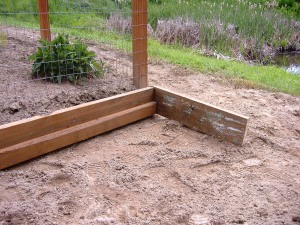
(5) Using your circular saw, cut a rabbet in the end of each of the four 8’ 4×4 posts to allow you to inlet a 2×4 board at the top of the post.
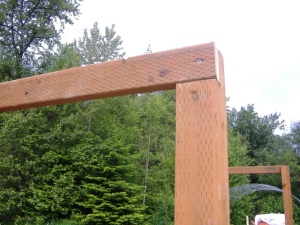
(6) Using a post hole digger, dig four post holes for the 8’ 4×4’s just under the lip of the short ends of the hoop house. They should be spaced so that there is a gap of 2 feet between them which will make them approximately 21 inches in from each long side as shown below:
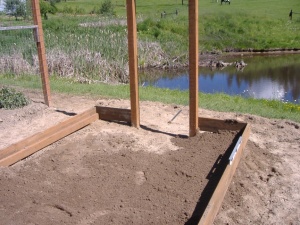
(7) Cut two 31” pieces of 2×4 board and fasten them to the tops of the 4×4 posts with deck screws flush with the outside of the posts. In addition to forming the top of the door or window frame, these 2×4’s will support the 2×4 king rafter that will keep the hoops from collapsing under a snow load.
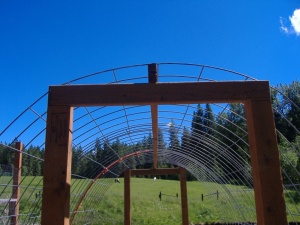
(8) Take one of the three remaining 2×8’s and cut it into four 22 1/4″ boards with one 27 1/2″ board remaining. Fasten the 22 1/4” boards so that the end that meets the long side board is flush with the end of it and the end that fastens to the 4×4 post has a gap of 1 3/4”. This gap will leave room for the doors to open and close.
NOTE: While fastening the end pieces, you might want to employ your tape measure to make sure the greenhouse remains reasonably square.
(9) Once you’ve completed the framework of the greenhouse, you can slide your cattle panel hoops over it. This is a bit tricky and can take 2-3 people, but once you have the ends of the hoops resting on the top of the 2×4, fasten the bottom edge to the 2×8 with fencing staples.
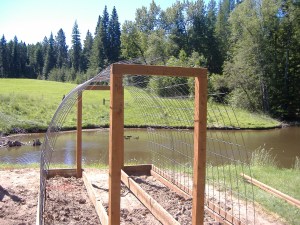
(10) At this point, you can fasten down the side walls of the greenhouse so that the whole thing doesn’t lift up and go rolling down the hill in the first stiff breeze. Locate your six pieces of rebar at the ends and middle of each long side of the greenhouse and pound them into the ground using the sledge hammer. Pound them down so that they are under the top edge of the 2×10 and, so, will not come in contact with the greenhouse plastic to tear it. Using the screw gun, 1 1/2” deck screws and pipe brackets, fasten the rebar, top and bottom, to the end boards.
(11) You can see that I boxed in my greenhouse beds and covered the path between with landscape fabric and gravel. I plan to add stones or concrete pavers to the path to act as a heat sink and to increase weed suppression.
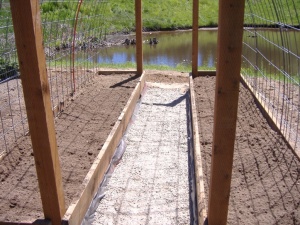
(12) It’s unlikely you’ll find a ready made door to fit your greenhouse so you’ll have to build one using 2×4’s and the clear PVC panels. Measure your door opening and cut two long and two short pieces of 2×4 to fit the opening. Cut the ends of the 2×4’s to make lap joints:

Use 1/2″ deck screws and glue to fasten the 2×4’s together. Once the the frame is assembled, you can cut pieces of clear, corrugated, PVC roofing to fit the door and fasten your hinges to one side.
Note: I needed to put more cross-bracing on my 2×4 door. The lap joints alone didn’t keep door from racking/warping so now I have to take the whole thing apart and reinforce it to stay square! Diagonal bracing is definitely a necessity.
(13) The last step before putting your greenhouse plastic over the frame is to cover the ends of the cattle panels with soaker hose. Split the soaker hose down one side and slip it over the ends of the cattle panel hoops from one side the other. If they aren’t tight enough to stay put on their own, use duct tape or zip ties to fasten them to the cattle panels. This will protect the greenhouse plastic from getting torn.
(14) Finally! It’s time to fasten the plastic to the frame! Use the piece of plastic you’ve cut and position it over the frame so that it is centered from front to back and side to side. Staple the plastic in place temporarily in place on the bottom support boards and around the door frames. Then, screw the 1×2 boards over the ends of the plastic on the sides and around the door frame to more permanently hold down the plastic.
The picture below doesn’t really do justice to the finished greenhouse, but it does show a few features. You can see the soaker hose covering the sharp edges of the cattle panels, and you can see how the plastic wraps about to the door frame edges. You can also just barely see the greenhouse door on the right.
This was the first year I used this greenhouse to grow tomatoes (hence the red plastic mulch intended to promote the ripening of fruit). You can’t see them (they’re under the plastic), but I used drip irrigation to water the plants and bailing twine to trellis them. You can just see the yellow bailing twine on one of the plants on the left.
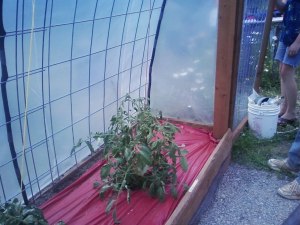
So, do not despair! You don’t have to give up salsa just because you live in an area more suited to berries than tomatillos. You too, Virginia, can have a greenhouse.

